Just like our marriages, nothing’s perfect about cars – whether they are new cars or old cars. Here are a few things about new cars that are both good and bad:
Tire inflator kits –
To save weight (and make room in ever-smaller trunks) many new cars no longer have a spare tire at all. Not even a mini-spare. Instead, when you get a flat, you unbox a tire inflator (and repair) kit, usually packaged under the trunk floor or in a side panel storage cubby. It contains a small air compressor you plug into the car’s cigarette lighter – whoops, politically incorrect… meant to say “power point” – and a can of goo, basically, that mixes with the incoming compressed air, shoots into the flat tire – via the stem – and simultaneously plugs the hole and refills the tire.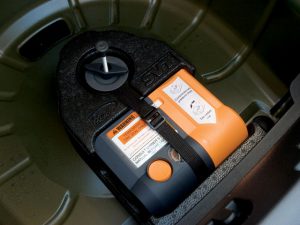
Upsides: You can get back on the road in minutes, without getting dirty. More room in the trunk for cargo, less weight to carry around and cost you gas. Also, instead of driving around on three normal-sized wheels/tires and one clown-car-sized “temporary use only” mini-spare, you get back on the road with four normal-sized wheels/tires.
Downsides: The repair/inflator kits can fix a nail in-the-tread flat but are useless if the flat is the result of a sidewall puncture or tear. Then you’ll wish you had a spare – even a mini-me spare. Your only option now is to call for roadside assistance. Also, they are one-shot-only fixes. Unlike a spare (standard or mini) that you can put back into the trunk for next time, you will need to get a new bottle of goo at the dealership – and it probably won’t be free.
Base/clearcoat finishes –
Modern cars have two layers of paint, the underlying color layer and – applied on top, to give it shine as well as protect the color coat from the sun and other environmental factors – a translucent layer of clear paint.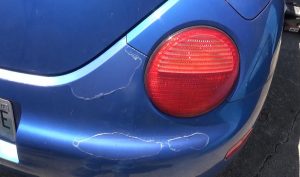
The upside of base/clear finishes is that the paint job holds up better to exposure – especially to the sun and chemicals such as road salt. Base/clear finishes are also pretty tough and resist chips.
The downside of base/clearcoat finishes is that if the clear coat begins to degrade – and this happens not infrequently – the fix is to repaint the car (or at least, the affected area). The shine of a base/clear finish can’t be brought back to life by rubbing compound and elbow grease – as was possible with the old acrylic/lacquer “one stage” painting methods. Once the clear coat yellows or cracks, that’s it. The shine is gone forever. Using rubbing compound will – usually – only make things worse.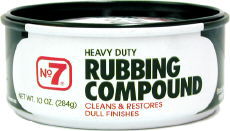
That’s because the shine comes from the clear. The underlying color coat is dull. Look at the underside of your trunk or hood or in the door jambs; many times these parts of the car’s body are painted but not clear-coated at the factory (to save a little money per car during manufacture). This is what the rest of your car would look like without the clear.
So if you use rubbing compound and rub off the clear topcoat, you’ll rub away the shine along with it.
Modern car manual transmissions –
It used to take much more effort to drive a car or truck with a manual transmission because the clutch was engaged and disengaged entirely by mechanical action – by your left leg, pressing it in and out. In vehicles equipped with powerful engines, this could be like doing leg presses at the gym – the clutch being much stiffer to cope with the power of the engine.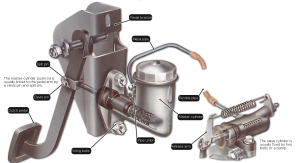
Then – beginning in the ’80s – clutches got hydraulic assist. Just as when you press on the brake pedal, you are actually depressing a column of fluid that transmits the force to the brakes, when you depress the clutch in a modern car with a manual transmission, the same thing is going on. Hydraulic fluid – which can’t be compressed – transmits the force (applied by your left leg) to engage and disengage the clutch.
Upside? The car is much easier – less tiring – to drive. Especially in stop and go traffic. Also, most modern hydraulically-engaged clutches self-adjust to compensate for clutch wear, so the clutch itself generally lasts much longer, often as long as 150,000 miles or more.
Downside? When the hydraulic system fails, the car will be undriveable, no matter how “good” the clutch is. And in some cars, critical parts of the system – such as the slave cylinder – can’t be gotten to without removing the transmission from the vehicle. That’s usually at least several hundred dollars in labor – plus the parts you need.
The good news here is that most new cars can go about twice as long in between oil changes as was routine in the past – generally, about 6,000 miles and twice a year vs. every 3,000 miles (and every three months or so) before the ‘90s. Some current/recent-vintage cars can go 10,000 miles or even more in between oil changes – and their engines are equipped with sensors that can actually sample the condition of the oil and tell you when it’s necessary to change the oil.
The bad news is that this savings – not having to get the oil (and filter) replaced as often – is wiped away to some extent by the much higher cost of oil (and filters). Synthetic/semi-synthetic oil – which many new car engines require – can cost $10 or more per quart, which is about twice or even three times what oil cost back when changeout intervals were more closely spaced.
It’s nice to be able to see where you’re going. All new cars have excellent headlights – especially vs. what was typical of cars built before the mid-late 1990s, when most new cars came with (at best) sealed beam halogen headlights. In comparison with modern headlight assemblies – LED, high intensity discharge/projector beam – they were not much better than a couple of flashlights bolted to the hood.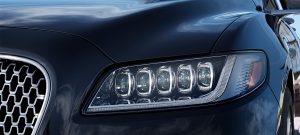
But – on the upside – sealed beam headlights were inexpensive, in part because they were pretty generic – usually either round or square, one or the other type fitting a variety of different models. They cost about $25 each. Also, they were made of glass and so pretty tough . . . relative to the plastic headlight assemblies that all new cars come with. Which are more fragile and a lot more expensive to replace when damaged, in part because they tend to be specific to a particular car rather than generic. It’s not uncommon for a single headlight assembly to cost $100 or more.
Sometimes, a lot more.
If you like what you’ve found here, please consider supporting EPautos.
We depend on you to keep the wheels turning!
Our donate button is here.
If you prefer not to use PayPal, our mailing address is:
EPautos
721 Hummingbird Lane SE
Copper Hill, VA 24079
PS: EPautos stickers are free to those who send in $20 or more to support the site. 




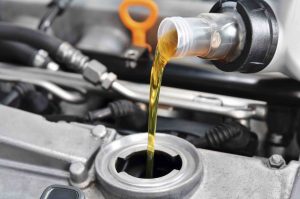







I never realized my 77 Triumph Spitfire was ahead of it’s time with a hydraulic clutch.
I had a 78′ Spitfire for my first car in high school…the hydraulic clutch cylinder went and leaked all over the left side of the bonnet, but at least it was easy to fix after the damage to the paint.
That car made me a mechanic early in age, not by choice- but I had some good times in it. I drove it on the 3 cylinders for a bit after a rocker arm exploded and the piston came up and hit/bent it in place- what finally did it in is when the rear axle u-joint snapped pulling into my driveway and the car lurched up in the air right before the rear wheel buckled under and slammed the rear of the car back down on top of it sideways…lol
As far as headlight replacement goes, I’ve found it to be rather inexpensive. The first ones I ever replaced were on a ’94 Dodge Ram. They were $98.00 for the pair in 2011. Next time (2 years ago) it was for my wife’s ’01 Focus; $68.00. The latest replacement (May ’17) was for my ’01 Camry. Both headlights, all 4 bulbs included, was $46.00. It would cost that much for just the bulbs if I went to the local parts store. The price of those assemblies have really been coming down.
Hi Joe,
One problem that is going to become more obvious in the years ahead is the way shortened product lifecycles (that is, how long a given design, not just of headlights but the cars themselves, remain in production) will lead to parts scarcity and high parts costs.
Car maker X produces headlight assembly design Y for four years. The car is replaced with a new model. Parts for the old model are no longer produced; the supply decreases and costs go up. Maybe a Chinese company will make a knock-off replacement. But not necessarily. Some of these headlight designs are intricate and expensive to make no matter who makes them and if there’s not a large enough potential market…
Your Camry is not a good example because it is a car produced in large numbers and – up to now – Toyota has been very conservative about making major design changes every 3-4 years.
Wait.
Or try to find parts for a car produced in much smaller numbers – and for a shorter period of time…
Chinese knock-offs but not OEM. Usually good enough.
Plastic headlights, however gorgeous when new, will tarnish and yellow after 5 or so years in the sun, even if undamaged otherwise. I have heard and seen mixed results from those “headlight restoration” kits….
Another disadvantage to tire goo is that you might get charged quite a bit extra to fix the flat. I was told this when my motorcycle got a flat (fortunately I wasn’t using goo).
I find hydraulically assisted clutches an oddity. Having started driving in the ’70s many of my vehicles and dad’s vehicles had old, manual clutch stick shifts. None of us ever found them to be tiring or a problem. As usual, though, the candy-ass American public puled and whined and now we have another layer of complexity and cost.
Fresh oil is always good for an engine. Running an oil for 10,000 miles guarantees that the crud in it will circulate that long and the additive package will be long expired. Synthetics are a false economy, in my opinion.
Being a stick-in-the-mud fart, I like the sealed beam headlights. They can be touched without oil from the hands burning them out, and their removal is a lead pipe cinch. I don’t think I’ve ever paid more than eight or nine dollars for one. On the other hand, I actually had to go to YouTube to find out how to replace the bulb in my Honda.
Generally the public lives for complexity and convenience. They’re not concerned about how wretched expensive their cars will be to fix in seven or eight years because they’ll have another new one before then. It’s schlumps like me who are going to suffer these wonder cars when they get old and gremliny. But, as my coat of arms should say, The Public has Decided for Me.
I have one car with a solid mechanical linkage clutch. One care with cable actuated clutch. One car with hydraulic clutch with the slave outside the trans, and one with the slave inside the bell housing. The Z-bar mechanical linkage is not that great. I prefer the hydraulic. Even though they share the brake fluid the clutch master cylinder is below the brake master cylinder. So if there is a brake line leak the clutch should still have fluid. It would have to fight gravity to drain out.
Synthetic oil is very good. Much better than dino in keeping an engine clean. Engine oil can last a very long time as those doing oil analysis to determine when to change have proven.
One of the most enjoyable to drive cars I ever owned was a ’77 Trans Am with the “T/A 6.6” 400 (this was the performance version of the 400 that year) paired with a Super T10 4-speed. The clutch was a little stiff but the feel of it was superior. I love my current TA but the other one was a hoot and a holler!
Hey eric, I had that exact car as my first car (dad is a gear head) and while I loved it and the foxbodies (cable linkage) I had later every one of those clutches is garbage compared to a hydraulic clutch. I’ve had multiple foxes and the TA leave me “stranded” when the cable snapped or in the TA’s case a bolt worked it’s way loose and then the whole linkage went to shit. I use quotes because they never actually leave you stranded and neither does a hydro clutch, start the car in gear and as long as one can no clutch shift you are on your way. I also had an e28 BMW hydro clutch crap out on me and the same method works. I do agree 110% about the complete lack of foresight used when placing a slave inside the bell housing, it’s a real dick move by the manufacturer.
Cheers and thanks as always for the great content.
You bet, Devin!
I just got attacked by a swarm of filthy compound-eyed stinging insects. They will be Final Solutioned shortly…
I had a cotter pin fall out of my ’73’s solid linkage once. It dropped the adjustment mechanism on the street. When I went for the next gear I found out the clutch pedal no longer did anything. I pulled off into an industrial park and found a parking lot where I learned what happened. I tried to kludge something with what was in the trunk and gave up. I started the car in gear and drove and restarted until I could pull into a driveway before it happened. I then walked the street until I found the parts. I then wired the whole thing together with a tether in case it came apart.
When I got home I fixed it properly with a new cotter pin and a wired tether. It’s now set up such that if the cotter pin fails the parts will be dangling and not fall to the street.
There are numerous polishes for clear coat paint. You just have to use the right stuff for what you have. It’s not a big deal. Although over the years I’ve come up with uses for the old number 7 polishing and rubbing compound and it would be shame if I couldn’t get it any longer. BTW, it can be used on clear coats to remove stubborn stains IME, just be careful because it isn’t buffered and will eat through with too much effort.
I like hydraulic clutches but I much prefer the old ones with the slave cylinder outside the bellhousing and with a completely separate from the brakes hydraulic system.
Here’s a question, one which you won’t have an answer to necessarily, but it concerns what I anticipate to be up and coming big brother regulations.
Headlight performance standards.
There have been some recent reports by some sort of automotive testing body (I don’t recall which) testing a small number of vehicles in a class for headlight performance. They assigned letter grades to specific makes and models based on their headlight performance in testing. The highest scoring models only got a C grade (“acceptable”) and the majority got much worse. These sorts of ratings are not currently part of regulations, but I expect they will become so.
Interestingly, it wasn’t always the higher end technology that performed better with the same model. If HID or LED or laser lighting systems were available on higher trims of the same model, they did not always perform better. So far I believe they have tested a small number of sedans and SUVs.
To my knowledge, this group is not testing older cars in any sort of head to head comparison. The performance standards are also, necessarily arbitrary.
Personally, I’m all for an independent, non-governmental body performing such safety testing and publishing the results. I’d feel the same for crash testing. It’s more information for the consumer to make decisions on. It also can help demonstrate some bare minimum safety level was met and reward higher performers for doing so. Underwriters Laboratories already performs this function, in a pass/fail manner, for electronic devices.
I’d have a problem if government decides they are the arbiters of what is and isn’t safe. They could easily demand that all cars have expensive LED headlights installed, even if they don’t consistently perform better than cheaper systems.
This seems like the next government fatwa, much like backup cameras recently were. I also suspect lane departure warning systems, early braking systems, and automatic high beam headlight systems will also soon be mandates.
A long time ago in a galaxy far far away I participated in a forum where a regular was a vehicle lighting engineer. From him I learned how the regulations work and why they are. Long story short the US headlamp regulations formulated in the 1930s as I recall, probably an SAE standard at the time later copied into FMVSS in the 1960s won’t be changing any time soon. The reason headlamps in the USA are poor performing is not just because they are allowed to be but because they are required to be. US DOT standards even if one pushes to make a good headlamp will find that it has various faults such as too much upward light because the USDOT requires it. The USDOT has no intention on changing to ECE (rest of the world really) standards because of not invented here, US regulations are better in their opinion, and market barriers to entry.
So don’t worry, there are minimum performance standards and they won’t be changing any time soon or ever.
Sounds about right.
Another downside to the tire-goo stuff — it can block the vent the TPMS sensor uses to see what the pressure is. Also your tire guy may decide that the goo-coated interior of the tire won’t provide a good seal for a patch (and he’ll be cursing the stuff for getting all over his tire machine). So not only will you be buying a new tire (or maybe four – if you have a full-time 4WD or AWD system) you’ll also be buying a new $80 sensor.
The hydraulic clutch I had on the 2000 CR-V was still good when I sold it, at nine years of age. This includes 8 hours of stop & go it took to get home in an ice storm, where I was grateful for the easy clutch feel as I feathered it to prevent the car from slipping off the road.
‘… I was grateful for the easy clutch feel as I feathered it to prevent the car from slipping off the road.’
That’s what I don’t like about losing manual options – layers of tech getting between you and where the rubber meets the road